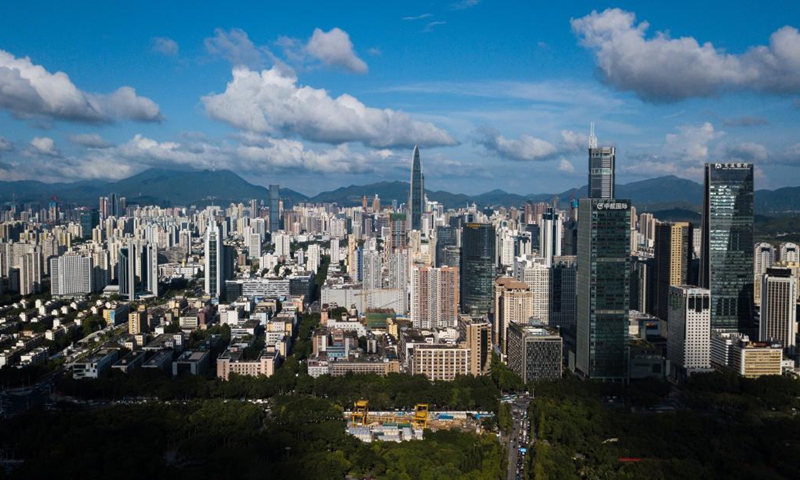
Aerial photo taken on Aug. 13, 2020 shows a view of Shenzhen, south China's Guangdong Province. (Xinhua/Mao Siqian)
Neighboring Hong Kong, Shenzhen in South China's Guangdong Province has become the most attractive city for new residents in the province and even in the whole country, thanks to its solid economic development, official data showed.
According to Guangdong's statistical bureau on Saturday, the population in the province as of the end of 2020 was 126 million, 21.7 million higher than in 2010 - a 20.81 percent increase in 10 years or an average yearly increase of 1.91 percent.
The population in Shenzhen as of the end of 2020 was 17.56 million, ranking second in Guangdong after the capital city Guangzhou, which had a population of 18.68 million.
It was notable that of the total population increase, 7.14 million people were added in Shenzhen, accounting for almost one-third of the total increase in population in Guangdong. It was higher than the total increase in population in East China's Jiangsu Province - 6.09 million - in the same period, making Shenzhen the most attractive city in the province, or even in China.
The fast-growing population is a reflection of the city's vibrant industrial development and the spirit of innovation, Li Chang'an, a professor at the University of International Business and Economics' School of Public Administration, told the Global Times on Sunday.
"Normally, economic growth and industrial development are the best ways to attract people, and Shenzhen, especially after China introduced the plan of building the Guangdong-Hong Kong-Macao Greater Bay Area, has almost done the best in this regard in the Chinese mainland," Li said.
According to the bureau, Shenzhen is also the "youngest" city in China, as the population of people aged 60 or above accounts for only 5.36 percent, which is 6.99 percentage points lower than the average provincial level and 13.34 points lower than the national level.
Shenzhen became a special economic zone that spearheaded China's reform and opening-up policies that started about 40 years ago.
After decades of growth, the city has become an example of China's fast development, as many of the world's leading tech companies - including internet giant Tencent and drone developer DJI - are based in the city and have grown exponentially.
"In addition to economic growth, Shenzhen's high-level innovation capability is another strong driver to attract people, especially top talent," Li added.
In a government work report on Saturday, Shenzhen's acting mayor Tan Weizhong said that the city's GDP in 2020 reached 2.77 trillion yuan ($430.3 billion), putting the city among the top five in Asia in terms of GDP scale.
According to Tan, Shenzhen plans to build the Shenzhen-Hong Kong ports economic belt, which includes building an international tourism zone, to promote the development of the Greater Bay Area.
In terms of technology and innovation, the city is planning to start 50 projects aiming to make breakthroughs on key technologies, and will attract top talent accordingly, he said.
"As cooperation among cities in the Greater Bay Area is getting closer, the movement of talent has become a two-way model instead of one-way model as before, when experts were only willing to move to Hong Kong and Macao," Li said.
As the cities in the Greater Bay Area are complementary in terms of industrial structure, such movement of professionals will only intensify, and this will also promote the area's economic development, according to Li.




